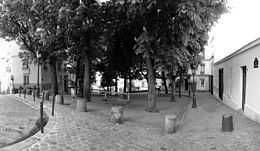Le Bateau-Lavoir

Le Bateau-Lavoir is the nickname for a building in the Montmartre district of the 18th arrondissement of Paris that is famous in art history as the residence and meeting place for a group of outstanding early 20th-century artists, men of letters, theater people, and art dealers. It is located at No. 13 Rue Ravignan at Place Emile Goudeau, just below the Place du Tertre.
A fire destroyed most of the building in May 1970 and only the façade remained, but it was completely rebuilt in 1978.
History

The name Le Bateau-Lavoir was coined by French painter Max Jacob. The building was dark and dirty, almost seeming to be scrap pile rather than a dwelling. On stormy days, they swayed and creaked, reminding people of washing-boats on the nearby Seine River, hence the name. It has been suggested that the structure was a manufacturing facility in the previous century.
The building stands on a small cobblestone square that was known as Place Ravignan. In 1911, it was rechristened Place Émile Goudeau for Émile Goudeau (1849–1906), a popular novelist, poet, and journalist who founded Les Hydropathes, a renowned literary club. The square now has a Wallace fountain and is planted with horse chestnut trees.
Maxime Maufra (1863–1918) was the first noted artist to take up residence in Bateau-Lavoir, around 1890.[1] Kees van Dongen and Pablo Picasso took up residence between 1900 and 1904. After 1904 more artists and writers moved in, including Pierre Mac Orlan, Juan Gris, André Salmon, Pablo Gargallo, Max Jacob and Pierre Reverdy. It became an unofficial club that included artists (Henri Matisse, Georges Braque, André Derain, Raoul Dufy, Marie Laurencin, Amedeo Modigliani, Jean-Paul Laurens, Maurice Utrillo, Jacques Lipchitz, María Blanchard, Jean Metzinger and Louis Marcoussis); writers (Guillaume Apollinaire, Alfred Jarry, Jean Cocteau, Gustave Coquiot, Cremnitz (Maurice Chevrier), Paul Fort, André Warnod, Raymond Radiguet, Gertrude Stein); actors (Charles Dullin, Harry Baur, Gaston Modot); and art dealers (Ambroise Vollard, Clovis Sagot, Daniel-Henry Kahnweiler and Berthe Weill).
While residing in the Bateau-Lavoir Picasso painted one of his most noted works, Les Demoiselles d'Avignon, considered by art historians as a proto-Cubist painting (the precursor of a movement that became known as Cubism in 1911).
Following the outbreak of World War I in 1914, creative artists living at the Bateau-Lavoir and in the neighborhood began moving elsewhere, mainly to Montparnasse.
Notable residents
- Pablo Picasso
- Pablo Gargallo
- Maxime Maufra
- Juan Gris
- Max Jacob
- Amedeo Modigliani
- Pierre Reverdy (1912–1913)
- André Salmon
- Endre Rozsda
- Kees van Dongen
- Guillaume Apollinaire
- Georges Braque
- Henri Matisse
- Ksenia Milicevic
- Jean Cocteau
- Gertrude Stein
- Auguste Herbin
Notable events
In 1908, a celebration banquet for Henri Rousseau was organized in Picasso's studio in the Bateau-Lavoir.
One night, Amedeo Modigliani destroyed a number of his friends' paintings while in an alcoholic rage in the Bateau-Lavoir, according to memoirs of his daughter, Jeanne.
See also
- La Ruche, in Montparnasse, Paris.
References
| Wikimedia Commons has media related to Bateau-Lavoir. |
- ↑ http://www.serdar-hizli-art.com/modern_painting/bateau_lavoir.htm Art Encyclopedia, entry for Bateau-Lavoir
Coordinates: 48°53′09.24″N 2°20′16.88″E / 48.8859000°N 2.3380222°E